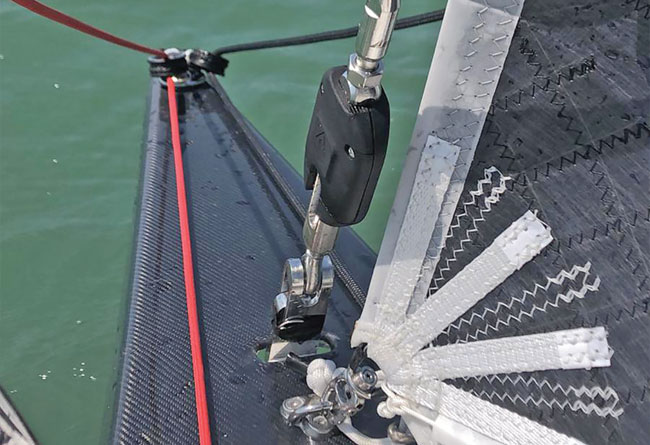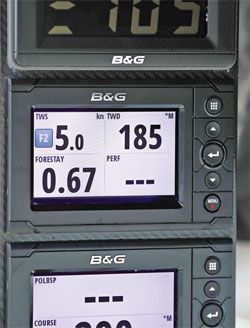

If you’re looking to be tested by your customers then Emirates Team New Zealand is a good place to start...
Getting the best performance out of a racing yacht is tough, with lots of controlled and uncontrolled variables in the equation to success. Accurate sensors are essential to provide the valid data on which crews can make decisions, and confidently repeat optimum settings for performance. Sensors for wind speed and angle, boatspeed and heading have evolved over the decades, and accurate calibration of these is (or should be) standard practice on every race yacht.
Rigging loads, mast shapes and sail shapes are much harder to measure accurately in real time, so all too often are not part of the performance game for most yachts, leaving much speed potential untapped. This is an issue particularly for the key measurement and control of forestay “sag”. Stu Bannatyne, winner of the Whitbread/ Volvo four times, says that ‘matching forestay tension to the wind and sails is key to upwind performance.’
As Eddie Warden-Owen, RORC CEO, former sailmaker and America’s Cup coach explains:
- Forestay sag is a key part of controlling the aero-shape of the headsail and enables you to create different sail shapes for different wind conditions
- Modern material is less stretchy and allows a sail to be used through a much wider wind range
- Forestay sag is measured by forestay load, and controlled by rig and backstays. More sag equals deeper headsail and more power. Less sag equals flatter headsail for stronger wind
- Accurate knowledge of forestay sag enables you to repeatably adjust this to give known optimum sail shape for best performance throughout the race
- Finding the right shape is achieved by trial and error or working with your sailmaker who can provide feedback on the photos you take
So how to measure forestay load accurately and repeatably? Grand Prix yachts build in a load measurement system at the design stage, but most of us are unable to retro-fit these, and rely instead on pieces of tape, rulers and pen marks on the deck. In the modern world of “Internet of Things” technology, isn’t there a better way?
Below: ʻplug and playʼ integration with B&G instruments ensures that Smartune Uno is as easy to retrofit as possible

Smartune Uno is a clever new product from Cambridge company, Cyclops Marine, that offers an innovative new solution to measure forestay load and display live on the instruments, enabling crews to adjust the load and hence shape in response to wind conditions as they race. Simple enough for crews to retro-fit at the dock, Smartune Uno now makes repeatable headsail shape control available to yachts of all sizes, at all levels. Testing the system on his yachts across the UK and US, Stu Johnstone of J-Boats reported, ‘it works! Forestay sensor on J/99 - B&G picked it up right away!’
Available in a range of standard rigging sizes, the Smartune Uno package consists of a wireless forestay load sensor, which simply screws into the forestay as a direct replacement for the existing turnscrew, and sends data wirelessly to the instrumentation gateway mounted below decks. This plugs data directly into NMEA2000 systems and can also send live data to smartphones over WiFi. As with all smart fittings from Cyclops, Smartune sensors are individually calibrated at manufacture, so can be trusted to display accurate load data “straight out of the box”.
‘Installing Smartune is as simple as taking turns off a turn screw to adjust the mast rake. This is definitely a system anyone can install on their own boat,’ says Hannah Diamond, Volvo Ocean Race sailor and Olympic offshore doublehanded campaigner.
Cyclops was founded in 2018 by Vincent Geake (former navigator and technology manager for America’s Cup, Volvo and Admiral’s Cup teams), to bring the latest technologies and engineering innovation to load measurement in yachts: rigs, sails and foils. Already selected to provide load sensing for Emirates Team New Zealand, Cyclops is building a reputation for developing “smart fittings” for race yachts and superyachts around the world, displacing traditional load measurement products. A key Cyclops design principle is direct measurement of tension and compression loads in rigs, rather than indirect measurement via sensors like shear loadpins, which are challenging to correctly install and maintain for reliable accurate data.
Building on this success, Cyclops is now bringing its smart fittings technology to the wider race yacht market. Sam Cray, Smartune technical support engineer, believes Smartune Uno can help anyone wanting to extract maximum performance (and enjoyment) from their yacht. ‘Smartune technology now provides the data on rig tensions and performance settings, enabling racers to keep “changing gear” as conditions change. Ultimately it’s about helping to get the boat moving fast, then keeping it fast as well!’
Of course, Smartune sensors can be fitted in place of turnscrews anywhere in the rigging to give accurate repeatable settings or under/overload warnings. ‘We’re already getting people asking about measuring loads in upper and lower shrouds to control mast bend, and to limit overload’, Geake says.
Click here for more information on Cyclops Marine »
We invite you to read on and find out for yourself why Seahorse is the most highly-rated source in the world for anyone who is serious about their racing.
To read on simply SIGN up NOW
Take advantage of our very best subscription offer or order a single copy of this issue of Seahorse.
Online at:
www.seahorse.co.uk/shop and use the code TECH20
Or for iPad simply download the Seahorse App at the iTunes store


